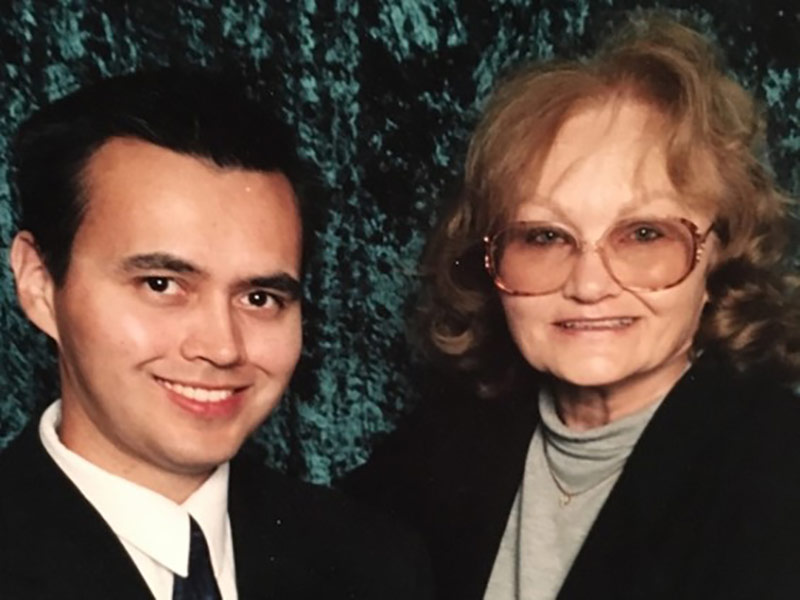Shirley Williams was afraid she was going to get killed by the police.
And on April 21, 2016, the 73-year-old woman’s fears were realized, as she and her son Jovan Williams, 39, were both shot and killed when four RCMP officers came to their house in the tiny northern B.C. community of Granisle.
An inquest into the shooting deaths began in Smithers on Monday, offering a glimpse into the lives of a strong and passionate woman who increasingly expressed fears over her safety, and her son, an Indigenous man described as quiet and shy, who moved into her home to protect her.
Shirley and Jovan Williams died when officers came to their house following an altercation with a neighbour. Jovan was shot behind the house and Shirley killed moments later, when she followed her son out back, according to facts read by inquest counsel Christopher Godwin.
Shirley was remembered as a well-appointed, hard-working woman who was fierce when it came to social justice and never hesitated to say what was on her mind.
But she became increasingly fearful in her final years, believing her neighbours were trying to run her out of town and keeping a log of what she believed was suspicious activity in her community, including police behaviour.
Shirley believed she would die at the hands of police, the five-person jury heard.
“She was really scared for a long time,” her ex-husband, Harvey Williams, said during testimony. “She was scared she was going to get killed by the police.”
Harvey and Shirley’s son, Jovan, was described by many who testified Monday — which included family members, a friend, a neighbour and medical professionals — as quiet and shy but, like his mother, someone who spoke up when he felt someone had been wronged. A ticketed carpenter, he was creative and loved to draw, read DIY books and figure out how things worked.
“He was a very reliable person. If you needed help, he was there,” his sister, Shonte Williams, said in a letter to the jury read by Godwin.
“We were a whole,” Shonte said about her family. “Everything died with them. They were my best friends.”
The purpose of the inquest, stressed presiding coroner Larry Marzinzik, is not to find fault but to determine what led to the deaths and form recommendations aimed at preventing future similar deaths. The inquest continues until Friday, when the jury will begin its deliberations.
The inquest was originally scheduled for June 2020 but was postponed due to the pandemic. Inquests are required for any deaths occurring while in police custody.
Harvey Williams broke down as he thought of the last time he saw his former wife, standing in the doorway of her Granisle home following the Christmas holidays several months before her death.
Shirley loved the holidays, and no one was ever turned away for Christmas dinner, Shonte said. Even after Shirley and her husband, Harvey, separated 40 years ago, the family stayed close and came together several times a year for holidays.
“She really loved us all,” Harvey said, adding about his son, “Jo was a really good kid. He never smoked, he never drank, never partied around.”
The couple met about 50 years ago in the southern U.S., where Shirley was born and raised. Harvey was travelling in Tennessee when he stopped at a restaurant in Nashville, he said. There, he met Shirley and the couple formed a relationship that endured, even when Harvey returned to northern B.C.
He would go back to Nashville to be with Shirley, spending a year there before the couple moved north and settled near Burns Lake. They married in 1973, he said, and had two children — Shonte and Jovan. After they separated in 1981, Harvey moved to Fort Fraser to be closer to work, and Shirley stayed with the kids in Burns Lake. But they remained close, spending holidays together and connecting frequently over the phone, Harvey said.
Chief Corrina Leween of the Cheslatta Carrier Nation said she had known the couple since she was a child, and Jovan from the time he was a baby. Jovan had family in both the Lake Babine and Cheslatta Carrier nations through his father’s side, she said, and the band had sponsored him to do his Red Seal carpentry ticket.
Jovan was “always pleasant” when he came into the band office, Leween said.
Shirley was repeatedly described as a hard worker who fought for the rights of her co-workers.
“One thing I’ll always remember was what a hard worker she was, even when I was really little,” Leween said. “I found her to be extremely diplomatic but very stern in her beliefs in the rights of individual people.
“She was always very straightforward but very loving at the same time.”
Shirley was a woman ahead of her time, the jury heard. Growing up, she was among the first in Memphis to acquire credit without having a man co-sign. When she arrived in Burns Lake, she got a job at the local pulp mill at a time when few women were working in the forest industry, Harvey said.
She was a union rep at her company who fought for the rights of her co-workers, frequently making a significant difference in people’s lives and working conditions, Shonte said.
After her retirement, she moved to Granisle, on the shores of Babine Lake, about 100 kilometres north of Burns Lake.
She was a religious person and a strong believer, Harvey said. As a dedicated churchgoer and community organizer, she frequently did volunteer work in her early retirement years, dedicating her life after retirement to Bible study.
But while she initially found community with her church, rifts gradually developed, and Shirley stopped attending. She began to distance herself from others in the community of about 300 as she became increasingly fearful for her safety, according to her ex-husband.
After finishing his carpentry training, Jovan moved to Granisle to be with his mother.
“Shirley got scared,” Harvey said. “She thought the cops were going to shoot her.”
Shirley began recording police incidents in a book that she kept in her home, according to several people who testified. She also logged her concerns about ongoing disputes with her neighbours.
According to Harvey, the small community was rife with racism.
“People in Granisle don’t like us Indians,” he said. “The white people in Granisle really hated us people. They didn’t like us for neighbours.”
When asked by Godwin if Shirley appeared to have distanced herself from reality, Harvey responded with a firm “no.”
But others were beginning to question changes in Shirley’s mental health, the jury heard.
A neighbour, Jim O’Farrell, also a village councillor in Granisle, said he had concerns that he expressed to the local nursing clinic. He said that about a year and a half before her death, Shirley came to his door wanting to talk about her journal and the records she’d been keeping.
“It got me a little worried because at the time she wasn’t making very much sense,” O’Farrell said. He added that another neighbour, who had been friends with Shirley, had distanced herself after noticing a change — Shirley had gone from being caring and community-minded to forwarding strange theories.
“She thought people were out to get her,” he said.
After reporting his concerns to the nursing clinic, O’Farrell made another visit to Shirley’s home and attempted to reason with her, he said, but she asked him to leave.
“I never had contact with her again,” he said. “It was very off the wall. I was surprised she didn’t have help.”
Shirley expressed uncertainty about her own perception of her experiences, according to a family physician who saw her four times in 2013 and 2014 in Burns Lake.
“She was remarkably healthy,” said Dr. Loren Caira, who noted arthritis had initially brought Shirley into the Burns Lake clinic and that she was not on any medication.
But the last time he saw Shirley, in February 2014, it was her own concerns about her mental health that brought her into the clinic, as she sought help in verifying her experiences. She began the consultation with “You might think I’m crazy…” he said.
“She was looking for verification this was real, and this was really hard to do,” Caira said. “I think she was probably developing a psychosis, likely due to stress of someone who lives in a remote area with friction with a neighbour.”
Shirley shared her journal, where she had logged incidents that she believed to be suspicious, with the doctor.
“She had a number of really delusional ideas,” he said.
Caira said she believed that, for about five years, people had been trying to “run her off” by vandalizing her property. Her suspicions ranged from thinking someone had changed her bank PIN and withdrawn money from her account to blaming a neighbour’s hair loss on his attempts to project radiation at her house, Caira said.
While he referred her for a psychogeriatric assessment, he doesn’t know if it ever happened. “They don’t see everyone who’s referred to them. They simply don’t have the manpower,” he said.
Both Caira and Danielle Lanneville, a community health nurse working in Granisle at the time, suggested Shirley seek assistance from RCMP over her vandalism concerns, the jury heard.
Lanneville said she reached out to Shirley after concerned friends from her church had contacted the Granisle nursing station about changes in her behaviour, describing her as increasingly angry and paranoid. She asked to visit her in her home, but Shirley declined, Lanneville said.
Shirley insisted she was the victim and “not crazy,” said Lanneville, reading from her notes, which described Shirley’s “obvious paranoia.”
Under the Mental Health Act, medical professionals are required to report to the Ministry of Children and Family Development and RCMP if someone who appears vulnerable may be a danger to themselves or others, she said. Without seeing Shirley in person, Lanneville didn’t feel she could properly assess her mental health, she added.
When two other community health nurses did a home visit in February 2014, after Lanneville had left the community, they found the house cluttered, with gun safety books on the coffee table, a strong smell of bleach and motion sensors installed in the home, she said.
Dr. Michael Graetz, a family physician in Burns Lake, said he saw Jovan several times in the years leading up to his death, mostly for traumatic, work-related injuries — things that were normal for a man his age, he said.
The last time Jovan visited the clinic, in February 2016, he said he had been hit on the shin with a baseball bat, the doctor said. Jovan wanted Graetz to document the injury, which included bruising and swelling on his lower leg, presumably for an RCMP report, he said.
Jovan appeared otherwise healthy, Graetz added.
The inquest continues today in Smithers, with the initial days intended to provide background information for the jury before moving onto the events that led up to the shooting. Amongst those still to testify this week, said inquest counsel Godwin, are experts in RCMP policy and use of force, firsthand witnesses, officers involved in the incident, a paramedic who attended, an expert toxicologist and a medical pathologist.
The RCMP will testify Wednesday, Nov. 3, Godwin said.
The neighbour involved in the conflict, Heinrich Fehr, has since died, Godwin said.
Although evidence on both deaths is being considered together, the jury has been instructed to form separate recommendations for each. ![]()
Read more: Rights + Justice
















Tyee Commenting Guidelines
Comments that violate guidelines risk being deleted, and violations may result in a temporary or permanent user ban. Maintain the spirit of good conversation to stay in the discussion.
*Please note The Tyee is not a forum for spreading misinformation about COVID-19, denying its existence or minimizing its risk to public health.
Do:
Do not: